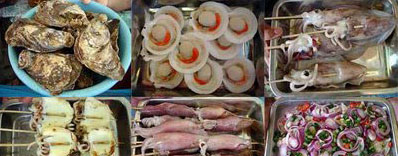CAPIZ - Seafood Capital of the Philippines

Discover the Capiz mystic. Explore the rolling hills, mountain peaks and ranges. Enjoy daytime excursions at the province’s wide beaches and isolated coves. Have a fill of a variety of seafoods available all year round. Visit local gardens, historical sites, old Spanish churches, Southeast Asia’s largest bell at Pan-ay Church, and the birthplace of Manuel A. Roxas (first Philippine President). Experience local festivals like Balintawakan and Sinadya sa Halaran. Go spelunking. A lot of caves are waiting to be explored. Or you can make special arrangements to witness the Mundo tribe dance in Tapaz.
Capiz History - Capiz, a province where myth and reality merge. One enduring legend about how Capiz got its name goes like this: Balingangan, Datu Bankaya’s eldest son, named his two territories “Kapid” and“Akean” (meaning twin) in honor of his twin daughters “Bulan” and “Adlaw” (moon and sun). Spaniards who later settled in the area adopted the names of Capiz and Aklan.
The arrival of Spaniards in 1569 brought about major changes in the lives of the Capizeños. May 8, 1570, marked the conquest of Panay and consequently the district of Aklan by the Spaniards under the leadership of Martin de Goiti. Capiz was created into a separate ‘encomienda’ and later was organized into a politico-military province in 1716, embracing the neighboring island of Romblon, Tablas, and Sibuyan. The American takeover of the Philippines resulted in the establishment of a civil government in Capiz on April 15, 1901.
The City of Roxas is the provincial capital of Capiz, a part of Panay Island where Miguel Lopez de Legaspi settled when he arrived from Cebu. In 1746, Capiz was made the seat of the politico-military government although it was still ecclesiastically controlled by the Bishopric of Cebu. On May 31, 1847, a Royal Decree turned the province into an alcadia. Roxas City was once known as the Municipality of Capiz and it became a chartered city on May 12, 1951 by virtue of Republic Act No. 603 otherwise known as the City Charter. The late Hon. Lorenzo Arnaldo was its first City Mayor. This city was named “Roxas City” in honor of its most illustrious son, the first president of the Republic of the Philippines, President Manuel Acuña Roxas.
 Geography - The Province of Capiz occupies a land area of 2,633 square kilometers, representing 21% of the total land area of Panay. It is composed of 16 municipalities and a city with a total of 472 barangays. The province is composed of 16 municipalities comprising 473 barangays. It is divided into two political districts: 1st District covers the municipalities of Maayon, Panay, Panitan, Pilar, Pontevedra, Pres. Roxas, and Roxas City; while the 2nd District covers the municipalities of Cuartero, Dao, Dumalag, Dumarao, Ivisan, Jamindan, Sapi-an, Mambusao, Sigma, and Tapaz.
Geography - The Province of Capiz occupies a land area of 2,633 square kilometers, representing 21% of the total land area of Panay. It is composed of 16 municipalities and a city with a total of 472 barangays. The province is composed of 16 municipalities comprising 473 barangays. It is divided into two political districts: 1st District covers the municipalities of Maayon, Panay, Panitan, Pilar, Pontevedra, Pres. Roxas, and Roxas City; while the 2nd District covers the municipalities of Cuartero, Dao, Dumalag, Dumarao, Ivisan, Jamindan, Sapi-an, Mambusao, Sigma, and Tapaz.
Population - As of the year 2000 survey, Capiz has a population of 654,156.
 Language - Hiligaynon is the dominant dialect spoken in the province.
Language - Hiligaynon is the dominant dialect spoken in the province.
Industries - The even distribution of rainfall throughout the year and the infrequent occurrence of typhoons make the province highly suitable for agriculture, aquaculture, and other related activities – which explains why these are major industries of the province. Farms for orchids, various ornamental plants, and different varieties of heliconia supply a thriving cut-flower business that is carving a market niche in Southern Philippine provinces. The land has also proven to be good grazing ground for cattle and for raising swine, goats, and poultry. Its long coastal areas abound with “kapis” shells, which are used in the manufacture of exportable novelty items. Numerous home and cottage industries amply augment household incomes, among which are poultry, livestock raising, handicraft, shell-craft, ceramics, lime processing, garments, farm-tool fabrication, furniture and boat making.
Capiz Is Famous For...
Sinadya sa Halaran - Literally meaning “Joy in Sharing and Thanksgiving,“ it fused two major festivals of Capiz – Sinadya and Halaran, which were previously celebrated separately. Sinadya marks the fiesta of Roxas City in honor of the Patroness of the Capiceños, Our Lady of the Immaculate Conception. Halaran festival depicts the rich cultural heritage of the Capiceños through sharing and thanksgiving, which the province and the city are celebrating together. The twin festival is celebrated in a show of unity that speaks of their determined quest for a better life.
Seafoods - The abundance of marine life makes Capiz the Seafood Capital of the Philippines. Home to one of the richest fishing grounds of the country, its water teem with the best that the sea has to offer – blue marlin, tuna, prawns and shrimps, seaweed, crabs ells, shellfish such as oysters and mussels, squid and other marine species. Prawns and milkfish are shipped by tons to Manila and other places.
 Birthplace of President Manuel Roxas - It was here in Capiz that the First President of the Philippines was born. Located in the city proper, the two-storey hardwood and stone house of President Manuel Acuña Roxas is now a historical shrine.
Birthplace of President Manuel Roxas - It was here in Capiz that the First President of the Philippines was born. Located in the city proper, the two-storey hardwood and stone house of President Manuel Acuña Roxas is now a historical shrine.
Biggest Bell - The Sta. Monica Church in Pa-nay, Capiz houses the biggest bell in Southeast Asia. The church’s five-storey belfry shelters a huge antique bell surrounded by 8 smaller bells. Shrouded with many enchanting tales, the huge bell holds more fascinating truth. It was cast from 76 sacks of coins believed to have been contributed by the citizens of the town. Its mammoth size holds a staggering record - seven feet in diameter and weighs 10.4 tons. 
Caves - Spelunking or simply cave exploration in just one of the many caves that can be found in Capiz is a delight to explorers and spelunkers. Getting into these nature-built dungeons, seeing the wonders that were hidden for centuries, creates a grand feeling of fulfillment as one views the grandeur of the chambers as big as the present-day cathedrals. Flaked tools and fossilized bones of Stone Age Man were recovered in some archeological caves.
Capiz Shells - Considered as the most versatile of sea shells, which are so plentiful in the province, called “pi-os” by Capiceños, but known as capiz throughout the world. Capiz shell products, admired for their beauty and transluscent quality, are in such great demand abroad that sometimes local exporters can hardly supply the needs of the market. The deft fingers of the Capiceños turn these shells into flowers and souvenir items of unsurpassed beauty.

Cutflower Growing - Farms of various ornamental plants and different varieties of heliconia supply a thriving cut-flower business that is carving a niche in Southern Philippines’ provinces.
Sulod Tribe - Located in Tapaz, Capiz, it is a cultural minority of Indonesian stock that worships spirits, practice secondary burial, and hunt with blowguns. The Sulod love personal ornaments. The necklace worn is not only an ornament and a status symbol but also an anting-anting or amulet.
Mussel Farms - Ten kilometers north of the town of Sapian, Capiz are the mussel farms that patiently lie like a silent picture of a thousand bamboo stilts arrayed six feet apart. Each bamboo pole stuck through the sea floor six to seven feet deep yields hundreds of fat dark green mussels neatly arranged like dark distended leaves sprouting heavily on top of each other. Get here by means of motorized banca, dugouts, or rafts.
Baybay Beach - The pride of Roxas City, located around 3 km. from the city proper of Roxas. This clean black sand beach is a favorite excursion/picnic area of the Capiceños.








 Birthplace of President Manuel Roxas - It was here in Capiz that the First President of the Philippines was born. Located in the city proper, the two-storey hardwood and stone house of President Manuel Acuña Roxas is now a historical shrine.
Birthplace of President Manuel Roxas - It was here in Capiz that the First President of the Philippines was born. Located in the city proper, the two-storey hardwood and stone house of President Manuel Acuña Roxas is now a historical shrine. 



 Officials in the
Officials in the 











